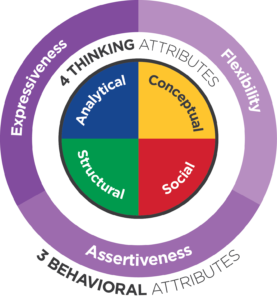Strategies to Deliver Powerful Presentations Using Emergenetics
Strategies to Deliver Your Message Across Thinking Styles
The key to making a Powerful Presentation is the ability to satisfy everyone’s needs – saying what they want to hear. Using Emergenetics as a framework, build rapport with audiences by appealing to Thinking preferences.
Consider the basic elements of what makes a great speech:
- Begin with an opening statement that tells the audience what you are going to tell them.
- Tell them what you want to tell them.
- Recap what you just told them.

The abstract (Analytical and Conceptual) thinkers will value an overview of what you are discussing. The concrete (Structural and Social) thinkers want you to keep things in order and tell them what to expect.
You likely won’t have the luxury of knowing the Emergenetics profiles of your audience. Powerful Presentations tap into all the senses and balances communication across all Thinking and Behavioral attributes. Include visual aids, sounds, and writing materials for all the brain styles in your audience.
When speaking to an audience where you do not have access to analyze thinking styles, it is important to balance the message to appeal to all thinking styles. This takes much practice and expertise. Too much delivery appealing to one thinking attribute and not of another risks losing a listeners attention. Read your audience as you present and adapt your delivery as appropriate to increase the effectiveness of your message.
Remember what triggers are important across the Thinking Styles. These triggers appeal to listening styles that often align to an individuals thinking style. Think about what triggers you and keeps your attention when listening to another team member or someone presenting to a group.
A Powerful Presentation will include reference to all the listening triggers.
Analytical: Why (Objectives & Analysis)
Conceptual: What (Goals & Vision)
Social: Who (Team & Communication Plan)
Structural: How (Logistics & Steps)
Appealing to the Analytical Brain
 Highly Analytical audiences want a presenter who is intelligent, knowledgeable, and in command of the subject. An Analytical brain will not take you seriously unless you have a thorough grasp of all the information you present.
Highly Analytical audiences want a presenter who is intelligent, knowledgeable, and in command of the subject. An Analytical brain will not take you seriously unless you have a thorough grasp of all the information you present.
- Give an overview and objectives.
- Use logic, data, facts, and precise, clear language.
- Provide written information, either ahead of time or afterward.
- Refer to credible sources.
- Highlight key information with graphs and charts.
- Summarize the concepts, but be prepared to provide the details in depth if you get challenged.
- Provide time for discussion, questions, and answers.
- Begin and end on time.
Appealing to the Structural Brain
 People who are very Structural prefer a conservative presenter. They are hands-on learners, so provide pencils, paper, and other support/learning tools. The Structural brain is typically uncomfortable with digressions. If you do follow a tangent, reassure your listeners that you will return to the agenda. Then be sure that you do.
People who are very Structural prefer a conservative presenter. They are hands-on learners, so provide pencils, paper, and other support/learning tools. The Structural brain is typically uncomfortable with digressions. If you do follow a tangent, reassure your listeners that you will return to the agenda. Then be sure that you do.
- Include personal experience with your biographical information to show you have ‘been there’.
- Prepare an agenda.
- Speak in and orderly fashion.
- Include all the details.
- Highlight key information with bulleted lists.
- Include implementation steps or an action plan.
- Provide time for questions and answers.
- Begin and end on time.
Appealing to the Social Brain
 The Social attribute prefers a presenter who is casual and an environment that is informal. Social learners like having their senses engaged with tactile objects. It is important to relate the elements of your presentation to how it impacts people.
The Social attribute prefers a presenter who is casual and an environment that is informal. Social learners like having their senses engaged with tactile objects. It is important to relate the elements of your presentation to how it impacts people.
- Share personal information along with your credentials.
- Make eye contact.
- Illustrate key information with stories and scenarios.
- Show emotion.
- Include pictures of people in your graphics.
- Show how information can be applied to the self.
- Allow time for sharing/input.
- Provide written instructions in addition to verbal instructions.
Appealing to the Conceptual Brain
 Conceptual thinkers prefer a presenter who can be casual and an environment that is informal. Conceptual learners enjoy pictures and metaphors and may need time to reflect. People who are highly Conceptual do not like being bombarded with a lot of details. They do like having an opportunity to figure things out for themselves – to connect the dots.
Conceptual thinkers prefer a presenter who can be casual and an environment that is informal. Conceptual learners enjoy pictures and metaphors and may need time to reflect. People who are highly Conceptual do not like being bombarded with a lot of details. They do like having an opportunity to figure things out for themselves – to connect the dots.
- Move quickly to gain the attention of the Conceptual brain.
- Give an overview along with a reason for paying attention that includes a vision of the future.
- Change your style of presentation every 10-15 minutes.
- Use metaphors.
- Summarize major points as you go along.
- Leave something to the imagination.
How to Kick Off Your Presentation
It goes without saying to kick-off a presentation by appealing to your audiences most preferred attribute. If this is not known, some recommend beginning a presentation with something that appeals to the left-brain, such as immediately clarifying the objectives and agenda. When applying Emergenetics, there has been much success in kicking off with something right-brained to capture the attention of the people who are highly Conceptual and Social, and then quickly follow with information the Analytical and Structural brains will need in order to feel comfortable.
The bottom line is to be very intentional in how you present to your audience to ensure you appeal to all thinking styles. With more experience, you will gain the ability to read your audience and adapt your message accordingly. This may come easier to some versus others. This is one reason why highly effective speakers are so rare. Challenge yourself and have fun!
